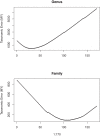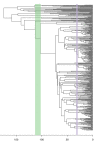A temporal banding approach for consistent taxonomic ranking above the species level
- PMID: 28536470
- PMCID: PMC5442095
- DOI: 10.1038/s41598-017-02477-7
A temporal banding approach for consistent taxonomic ranking above the species level
Abstract
Comparable taxonomic ranks within clades can facilitate more consistent classifications and objective comparisons among taxa. Here we use a temporal approach to identify taxonomic ranks. This is an extension of the temporal banding approach including a Temporal Error Score that finds an objective cut-off for each taxonomic rank using information for the current classification. We illustrate this method using a data set of the lichenized fungal family Parmeliaceae. To assess its performance, we simulated the effect of taxon sampling and compared our method with the other temporal banding method. For our sampled phylogeny, 11 of the 12 included families remained intact and 55 genera were confirmed, whereas 32 genera were lumped and 15 genera were split. Taxon sampling impacted the method at the genus level, whereas yielded only insignificant changes at the family level. The other available temporal approach also gives a similar cutoff point to our method. Our approach to identify taxonomic ranks enables taxonomists to revise and propose classifications on an objective basis, changing ranks of clades only when inconsistent with most taxa in a phylogenetic tree. An R script to find the time point with the minimal temporal error is provided.
Conflict of interest statement
The authors declare that they have no competing interests.
Figures




Similar articles
-
An Integrative Approach for Understanding Diversity in the Punctelia rudecta Species Complex (Parmeliaceae, Ascomycota).PLoS One. 2016 Feb 10;11(2):e0146537. doi: 10.1371/journal.pone.0146537. eCollection 2016. PLoS One. 2016. PMID: 26863231 Free PMC article.
-
Limitations of Species Delimitation Based on Phylogenetic Analyses: A Case Study in the Hypogymnia hypotrypa Group (Parmeliaceae, Ascomycota).PLoS One. 2016 Nov 9;11(11):e0163664. doi: 10.1371/journal.pone.0163664. eCollection 2016. PLoS One. 2016. PMID: 27828951 Free PMC article.
-
Who's getting around? Assessing species diversity and phylogeography in the widely distributed lichen-forming fungal genus Montanelia (Parmeliaceae, Ascomycota).Mol Phylogenet Evol. 2015 Sep;90:85-96. doi: 10.1016/j.ympev.2015.04.029. Epub 2015 May 16. Mol Phylogenet Evol. 2015. PMID: 25987532
-
Multilocus phylogeny of the lichen-forming fungal genus Melanohalea (Parmeliaceae, Ascomycota): insights on diversity, distributions, and a comparison of species tree and concatenated topologies.Mol Phylogenet Evol. 2013 Jan;66(1):138-52. doi: 10.1016/j.ympev.2012.09.013. Epub 2012 Sep 24. Mol Phylogenet Evol. 2013. PMID: 23017822
-
A review of criticisms of phylogenetic nomenclature: is taxonomic freedom the fundamental issue?Biol Rev Camb Philos Soc. 2002 Feb;77(1):39-55. doi: 10.1017/s1464793101005802. Biol Rev Camb Philos Soc. 2002. PMID: 11911373 Review.
Cited by
-
Neoprotoparmelia gen. nov. and Maronina (Lecanorales, Protoparmelioideae): species description and generic delimitation using DNA barcodes and phenotypical characters.MycoKeys. 2018 Dec 14;(44):19-50. doi: 10.3897/mycokeys.44.29904. eCollection 2018. MycoKeys. 2018. PMID: 30595656 Free PMC article.
-
Different diversification histories in tropical and temperate lineages in the ascomycete subfamily Protoparmelioideae (Parmeliaceae).MycoKeys. 2018 Jul 2;(36):1-19. doi: 10.3897/mycokeys.36.22548. eCollection 2018. MycoKeys. 2018. PMID: 29997448 Free PMC article.
-
Lichens and associated fungi from Glacier Bay National Park, Alaska.Lichenologist (Lond). 2020 Mar;52(2):61-181. doi: 10.1017/S0024282920000079. Epub 2020 May 11. Lichenologist (Lond). 2020. PMID: 32788812 Free PMC article.
-
The Genus Cetraria s. str.-A Review of Its Botany, Phytochemistry, Traditional Uses and Pharmacology.Molecules. 2022 Aug 5;27(15):4990. doi: 10.3390/molecules27154990. Molecules. 2022. PMID: 35956939 Free PMC article. Review.
-
Arcyria and allied genera: taxonomic backbone and character evolution.Fungal Syst Evol. 2025 Jun;15:97-118. doi: 10.3114/fuse.2025.15.04. Epub 2024 Oct 4. Fungal Syst Evol. 2025. PMID: 40170760 Free PMC article.
References
-
- Mayr, E. Systematics and the origin of species. (Columbia University Press, 1942).
-
- Mayr, E. Animal species and evolution. (Harvard University Press, 1963).
Publication types
MeSH terms
Substances
LinkOut - more resources
Full Text Sources
Other Literature Sources

